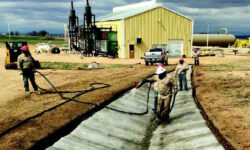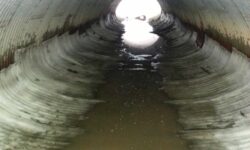Project Overview
Asphalt–emulsion had been used for years as a hard armor berm protection for a secondary containment system at a tank terminal site in Washington. Industry safety protocols state that berms must maintain a minimum height in order to provide an effective secondary containment and must be maintained at all times. However, frequent cracking of the berm led to high maintenance costs and operation disturbances from re-coating every five to seven years to repair cracking. Constant patch repair work throughout the year presented yet another challenge.
The asset owner first evaluated four standard procedures for secondary berm protection including vegetation cover, gravel cover, poured concrete/shotcrete, and liner cover.
1) Vegetative Cover: A vegetative cover protects the berm from erosion, but has high annual maintenance and safety costs based on continuous mowing and maintenance, potential grass fires, animal burrowing and weed abatement.
2) Gravel Cover: A gravel cover also protects the berm from erosion and eliminates vegetation maintenance. However, the gravel does not protect a soil berm from losing its low permeability requirements as a containment method. With gravel, the subsurface soil is more exposed to temperature fluctuations, precipitation and other weather conditions. It also does not eliminate animal burrowing, which greatly reduces the performance of the containment and can put it out of compliance.
3) Poured Concrete/Shotcrete: The use of poured concrete/shotcrete eliminates many issues associated with a vegetative or gravel cover, but
often faces cracking problems. Facility modifications or upgrades can become difficult and expensive using this method. Those tasks may include repairing existing pipes that penetrate through the armor protection, adding additional conveyance or infrastructure system, or increasing the height of the secondary containment.
4) Liner Cover: A liner cover eliminates the issues with a vegetative or gravel cover, but is not ideal due to UV and abrasion issues, as well as a lack of fire resistance characteristics.
Solution
After considering the benefits and risks of installing each of the above solutions, the asset owner selected Combat Concrete (CC) GCCM based on the significant cost savings associated with its simple installation and low required maintenance. CC offers hydrocarbon resistance to BS:14414; based on a 56 day immersion test at 50 degrees C. Furthermore, the product’s weed suppression characteristics prevent vegetation growth and associated fire hazards. CC is also a deterrent for animals to burrow and is more effective in protection than the impermeable layer of the berm, such as liner and/or compacted soils.
Results
Combat Concrete GCCM required a minimal daily operation disturbance during its installation, and upgraded the secondary containment berm to allow for possible future expansions. The completion of this project has resulted in drastically reduced maintenance costs, improved impermeability and fire resistance. The installation also enhanced the aesthetics of the facility while reducing safety concerns. Simple corner details and pipe protrusions accommodated a fast, easy installation. The client is very happy with the outcome and is looking to install CC on other berms in their vast oil and gas network.
Installation Overview
Western Refinery Services completed the installation over a seven-day period with minimal personnel. Bulk rolls were placed at the crest of the berm and spooled down one side before being unrolled down the other. This process was repeated along the berm, with a four-inch overlap established between layers.
Each overlap was screwed and sealed using 3/4-inch self-tapping screws placed at 12 inch intervals, as well as Sika 1-A sealant. On the inside of the berm, the cut edges of CC were placed into an anchor trench and then backfilled and compacted with an asphalt road base material. On the outer edge of the berm, masonry bolts were used to fix the CC to the existing concrete infrastructure and or placed into an anchor trench and backfilled with a compacted asphalt road base or gravel road base material.
In areas where the berm had eroded to the extent it no longer met the height requirements, sandbags were used to elevate the berm height before the CC was deployed. Infrastructure such as pipework was easily accommodated due to the drape characteristics and flexibility of CC. Holes were cut for the pipes and, where needed, an extra layer of CC was fitted around them and sealed. The CC was hydrated using a high-volume mounted hose attached to a water hydrant.




